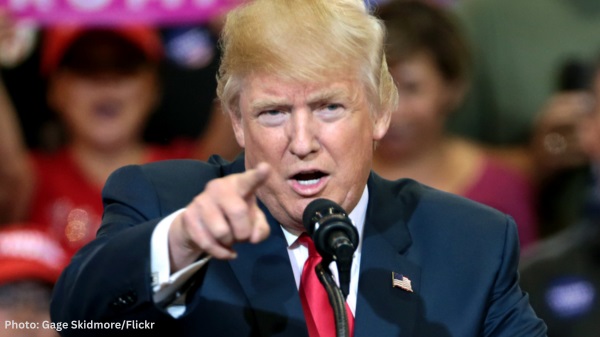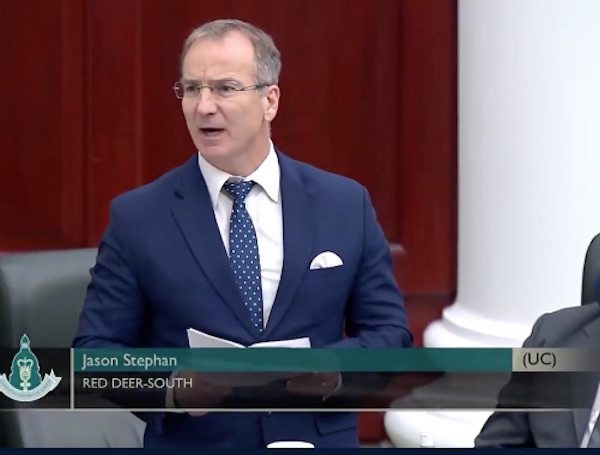International
‘Really, Really Difficult’: Bureaucrats Worry Behind Closed Doors They’ll Be Sent Packing Under Trump

From Heartland Daily News
“He’s going to get people in place that are more intelligent and are more loyal to him,” a park service employee said. “Now I think he could do a lot of damage.”
Government workers are reportedly in a state of panic over the prospect of former President Donald Trump winning another term in office, according to E&E News.
Bureaucrats up and down the federal hierarchy are concerned that a second Trump administration could cost them their jobs and put an end to liberal programs they worked to implement under President Joe Biden, E&E News reported. Trump has, if elected, pledged to implement reforms that would allow him to fire up to 50,000 civil servants at will, with the former president singling out workers who are incompetent, unnecessary or undermine his democratic mandate.
“The first rendition of the Trump administration was really, really difficult, and we saw a mass exodus of employees retiring,” a National Park Service employee told E&E News. “If we do have an administration shift, other employees will also reconsider their positions and move to the private sector. I don’t know what I’ll end up doing.”
Of the civil servants that didn’t exit during Trump’s first term, many worked internally to deliberately obstruct his agenda, according to Miles Taylor, who served as chief of staff in the Department of Homeland Security from 2017 to 2019 and admitted to engaging in such behavior. Bureaucrats are worried that Trump may seek to appoint administrators who agree with his agenda this time around.
“He’s going to get people in place that are more intelligent and are more loyal to him,” a park service employee said. “Now I think he could do a lot of damage.”
To replace large numbers of federal employees, Trump would reclassify them as Schedule F employees, allowing him to fire them at will. The Biden administration finalized a rule in April that would prevent their status from being changed involuntarily, however, allies of the former president have shrugged off the rule by pointing out that a Trump administration could simply reverse it, according to The New York Times.
Amid fear that Trump’s plans may come to fruition, bureaucrats are making moves to ensure the Biden administration’s policies are as hard to repeal as possible, a senior employee at the Interior Department told E&E News.
“The concern hasn’t been focused on who the Democratic nominee is as much as concerns about Trump winning and what that would mean,” they said. “From everyone’s perspective it is get as much done as possible. Also trying to bury into the agency programs [like environmental justice] so they can survive a Trump administration.”
Conservatives are increasingly optimistic about Trump’s chances of defeating Biden in November as the president lags behind Trump in the polls and the Democratic Party grapples with internal disputes regarding whether or not he should be their nominee.
“The mood is somber and incredulous,” one long-time employee of the Department of the Interior told E&E News. “The hope is we will not suffer through another term with the prior leadership, but the fear [is] that if we do, they will target employees they don’t like, make things up to justify whatever punishment they want and just cripple the good work we are doing.”
Staff at the Environmental Protection Agency (EPA), meanwhile, are also upset and agitated, the president of a union representing some of the agency’s employees told E&E News. “So many of our members lived through the absolutely disastrous first Trump administration and his attempted dismantling of EPA,” she said.
Originally published by The Daily Caller. Republished with permission.
Censorship Industrial Complex
A Democracy That Can’t Take A Joke Won’t Tolerate Dissent

From the Frontier Centre for Public Policy
By Collin May
Targeting comedians is a sign of political insecurity
A democracy that fears its comedians is a democracy in trouble. That truth landed hard when Graham Linehan, the Irish writer behind Father Ted and The IT Crowd, stepped off a plane at Heathrow on Sept. 1, 2025, and was met by five London Metropolitan Police officers ready to arrest him for three posts on X.
Returning to the UK from Arizona, he was taken into custody on the charge of “suspicion of inciting violence”, an allegation levelled with increasing ease in an age wary of offence. His actual “crime” amounted to three posts, the most contentious being a joke about trans-identified men in exclusively female spaces and a suggestion that violated women respond with a swift blow to a very sensitive part of the male’s not-yet-physically-transitioned anatomy.
The reaction to Linehan’s arrest, from J.K. Rowling to a wide array of commentators, was unqualified condemnation. Many wondered whether free speech had become a museum piece in the UK. Asked about the incident, British Prime Minister Keir Starmer defended his country’s reputation for free expression but declined to address the arrest itself.
Canada has faced its own pressures on comedic expression. In 2022, comedian Mike Ward saw a 12-year legal saga end when the Supreme Court of Canada ruled five-to-four that the Quebec Human Rights Commission had no jurisdiction to hear a complaint about comments Ward made regarding a disabled Quebec boy. The ruling confirmed that human rights bodies cannot police artistic expression when no discrimination in services or employment has occurred. In that case, comic licence survived narrowly.
These cases reveal a broader trend. Governments and institutions increasingly frame comedy as a risk rather than a social pressure valve. In an environment fixated on avoiding perceived harm, humour becomes an easy and symbolic target. Linehan’s arrest underscores the fragility of free speech, especially in comedic form, in countries that claim to value democratic openness.
Comedy has long occupied an unusual place in public life. One of its earliest literary appearances is in Homer’s Iliad. A common soldier, Thersites, is ugly, sharp-tongued and irreverent. He speaks with a freedom others will not risk, mocking Agamemnon and voicing the frustrations of rank-and-file soldiers. He represents the instinct to puncture pretension. In this sense, comedy and philosophy share a willingness to speak uncomfortable truths that power prefers to avoid.
Aristotle, in his Poetics, noted that tragedy imitates noble actions and depicts people who are to be taken seriously. Comedy, by contrast, imitates those who appear inferior. Yet this lowly status is precisely what gives comedy its political usefulness. It allows performers to say what respectable voices cannot, revealing hypocrisies that formal discourse leaves untouched.
In the Iliad, Thersites does not escape punishment. Odysseus, striving to restore order, strikes him with Agamemnon’s staff, and the soldiers laugh as Thersites is silenced. The scene captures a familiar dynamic. Comedy can expose authority’s flaws, but authority often responds by asserting its dominance. The details shift across history, but the pattern endures.
Modern democracies are showing similar impatience. Comedy provides a way to question conventions without inviting formal conflict. When governments treat jokes as misconduct, they are not protecting the public from harm. They are signalling discomfort with scrutiny. Confident systems do not fear irreverence; insecure ones do.
The growing targeting of comedians matters because it reflects a shift toward institutions that view dissent, even in comedic form, as a liability. Such an approach narrows the space for open dialogue and misunderstands comedy’s role in democratic life. A society confident in itself tolerates mockery because it trusts its citizens to distinguish humour from harm.
In October, the British Crown Prosecution Service announced it would not pursue charges against Linehan. The London Metropolitan Police Service also said it would stop recording “non-crime hate incidents”, a controversial category used to document allegations of hateful behaviour even when no law has been broken. These reversals are welcome, but they do not erase the deeper unease that allowed the arrest to happen.
Comedy survives, but its environment is shifting. In an era where leaders are quick to adopt moral language while avoiding meaningful accountability, humour becomes more necessary, not less. It remains one of the few public tools capable of exposing the distance between political rhetoric and reality.
The danger is that in places where Agamemnon’s folly, leadership driven by pride and insecurity, takes root, those who speak uncomfortable truths may find themselves facing not symbolic correction but formal sanctions. A democracy that begins by targeting its jesters rarely stops there.
Collin May is a Senior Fellow with the Frontier Centre for Public Policy, a lawyer, and Adjunct Lecturer in Community Health Sciences at the University of Calgary, with degrees in law (Dalhousie University), a Masters in Theological Studies (Harvard) and a Diplome d’etudes approfondies (Ecole des hautes etudes, Paris).
Daily Caller
Tech Mogul Gives $6 Billion To 25 Million Kids To Boost Trump Investment Accounts


From the Daily Caller News Foundation
Billionaire Michael Dell and his wife, Susan, announced Monday that they will give 25 million American children a $250 deposit as an initial boost to President Donald Trump’s new investment program for children.
The Dells’ pledge totals $6.25 billion and will be routed through the Treasury Department. The goal, they say, is to extend access to the federal Invest America program — referred to as “Trump accounts” — established by the One Big Beautiful Bill Act, signed into law by the president in July.
The federal program guarantees a $1,000 federally funded account for every child born from 2025 through 2028, but the Dells’ money will instead cover children 10 years old and younger in ZIP codes where the median household income is under $150,000, according to Bloomberg.
Dear Readers:
As a nonprofit, we are dependent on the generosity of our readers.
Please consider making a small donation of any amount here.
Thank you!
“What inspired us most was the chance to expand this opportunity to even more children,” the Dells wrote in the press release. “We believe this effort will expand opportunity, strengthen communities, and help more children take ownership of their future.” (RELATED: Trump Media Company To Create Investment Funds With Only ‘America First’ Companies)
Dell, founder and CEO of Dell Technologies with a net worth of about $148 billion, has been one of the most visible corporate leaders championing the Trump accounts. In June, he joined Goldman Sachs CEO David Solomon, Uber CEO Dara Khosrowshahi, and others at a White House roundtable promoting the initiative.
In addition to the new $6.25 billion pledge, Dell Technologies committed to matching the government’s $1,000 contribution for the children of its employees. Other companies, such as Charter Communications, Uber, and Goldman Sachs, have said they are willing to match the government’s contributions when the accounts launch.
“This is not just about what one couple or one foundation or one company can do,” the couple wrote. “It is about what becomes possible when families, employers, philanthropists, and communities all join together to create something transformative.”
Starting July 4, 2026, parents will be able to open one of the accounts and contribute up to $5,000 a year. Employers can put in $2,500 annually without it counting as taxable income.
The money must be invested in low-cost, diversified index funds, and withdrawals are restricted until the child turns 18, when the funds can be used for college, a home down payment, or starting a business. Investment gains inside the account grow tax-free, and taxes are owed only when the money is eventually withdrawn.
The accounts will “afford a generation of children the chance to experience the miracle of compounded growth and set them on a course for prosperity from the very beginning,” according to the Trump administration.
The broader effort was originally spearheaded in 2023 by venture capitalist Brad Gerstner, who launched the nonprofit behind the Invest America concept.
“Starting 2026 & forevermore, every child will directly share in the upside of America! Huge gratitude to Michael & Susan for showing us all what is possible when we come together!” Gerstner wrote on X.
-

 Business2 days ago
Business2 days agoRecent price declines don’t solve Toronto’s housing affordability crisis
-

 Daily Caller1 day ago
Daily Caller1 day agoTech Mogul Gives $6 Billion To 25 Million Kids To Boost Trump Investment Accounts
-

 Alberta1 day ago
Alberta1 day agoAlberta will defend law-abiding gun owners who defend themselves
-

 Business2 days ago
Business2 days agoOttawa’s gun ‘buyback’ program will cost billions—and for no good reason
-

 Business1 day ago
Business1 day agoCanada’s future prosperity runs through the northwest coast
-

 National1 day ago
National1 day agoCanada Needs an Alternative to Carney’s One Man Show
-

 Alberta21 hours ago
Alberta21 hours agoThis new Canada–Alberta pipeline agreement will cost you more than you think
-

 Artificial Intelligence2 days ago
Artificial Intelligence2 days agoThe Emptiness Inside: Why Large Language Models Can’t Think – and Never Will






